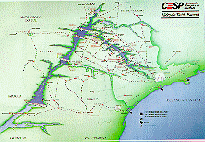|
Back 

PIRACICABA RIVER, WATERWAY TO DEVELOPMENT
More than 200 years ago, explorers, settlers, and travelers with
boatsloaded with food and guns sailed along the rivers Piracicaba,
Tietê and Paraná to the borders of Brazil and Paraguay.
Piracicaba was founded as a settlement to provide food and shelter
to these travelers. The Portuguese rulers wanted the city to be
on the mouth of the Piracicaba river but the captain in charge of
the city foundation chose the area of the falls, on the right side
of the river. Though located in a privileged area, the Portuguese
captain's decision kept the city excluded from the main routes and
later from the main highways that crossed the state.
After 229 years, the same river that made the foundation of Piracicaba
possible, became the city's gateway to development and progress,
integrating the city into the Tietê-Paraná waterway.
A railway connects Piracicaba to the Port of Santos and to the petrochemical
area of Paulínia. The port of Artemis will be the starting
gate to the South America Common Market (Mercosul).
Tietê-Paraná Waterway
After the second world war, the State of São Paulo started
building the Tietê dam to generate electricity. The 1.6 billion
dollar government plan included the building of locks in the Tietê
and Paraná rivers - a long-term government investment and
the only locks built in Brazil.
In 1991, with the opening of the Nova Avanhandava dam, the waterway
was used commercially. At the same time the Common South American
Market (Mercosul) became reality. The future prospects of the waterway
then included a connection to Argentine, Paraguay and Uruguay.
Within Brazil, this 1,500 mile waterway from Conchas to Itaipu
will carry 12 million tons of cargo, running through 170 million
acres (8.2% of the Brazilian territory) and changing the lives of
300 cities and 50 million people.
The first studies of the waterway were made in 1977 by Portobrás.
In 1983 three option were possible: the mouth of the Corumbataí
River located 4.5 km away from the city of Piracicaba, the city
of Artemis located 14.5 km away, and the Sorocabano site distant
24.5 km from Piracicaba. All the options were favorable to the city
of Piracicaba.
From 1983 to 1992 the projects were put aside. In 1993 local government
studies showed the Port of Artemis as the most logical connection
between the Tietê-Paraná waterway and the Port of Santos.
This proposal was accepted by the State and was technically analyzed
at the First International Seminar of the Tietê-Paraná
Waterway Development Program, which took place in New Orleans, USA,
in April 1993, attended by state officials, Cesp, investors from
Brazil and abroad.
In May, 1995, the State governor Mario Covas, Cesp and Piracicaba
Mayor, Antonio Carlos de Mendes Thame, signed a protocol for the
implementation of a waterway Development Plan for the Valley of
Piracicaba.
|


